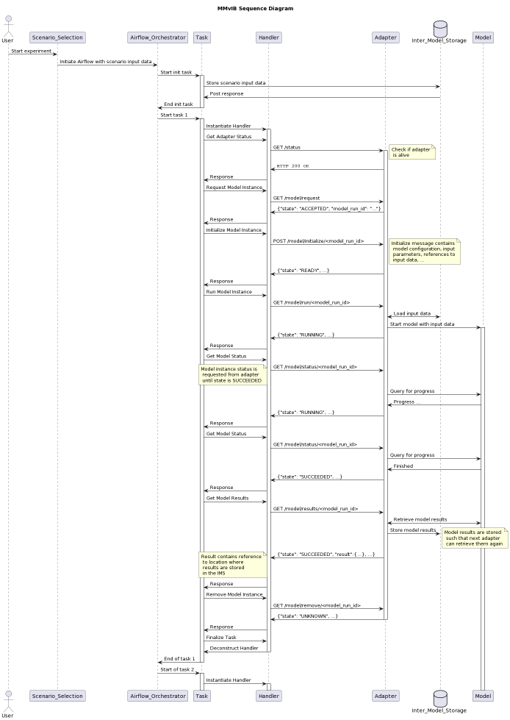Model adapters¶
General principles¶
Model adapters act as the interface between the orchestrator and the models
Model adapters make every model accessible in the same way
Model adapters all have the same (generic) API which makes it a lot easier at the orchestrator side
Model adapters are responsible for preprocessing of input data and postprocessing of output data
Model adapter lifecycle¶
One of the first things a model adapter needs to do in its initialisation process, is register itself with the model registry. This is done by sending a HTTP POST message to the registry API. By registring itself, the model adapter announces its presence and tells where it can be found. The orchestrator uses this information during the setup phase of a new workflow run.
…
Model adapter interaction¶
The following picture shows the interaction between the handler (inside Airflow), the adapter and the model.

Model adapter REST API¶
Every adapter should implement the following endpoints:
GET /request
- o Description:
The lifecycle is started by the model handler with the /request message, that can be used at the adapter side to set things up and reserve resources for this specific model run.
- o Returns:
model_run_id: a unique identifier generated by the adapter which the handler can later use to refer to this model run
state: ACCEPTED, PENDING, QUEUED, ERROR
reason: description in case of state ERROR
POST /initialize/<model_run_id>
- o Description:
Call to initialize the model
- o Body contents:
JSON containing model specific configuration parameters, settings, input values, references to file locations, …
- o Returns:
model_run_id
state: READY, ERROR
reason: description in case of state ERROR
GET /run/<model_run_id>
- o Description:
Call to start the model run
- o Returns:
model_run_id
state: RUNNING, …, ERROR
reason: description in case of state ERROR
GET /status/<model_run_id>
- o Description:
Call to retrieve the status of the model
- o Returns:
model_run_id
state: ACCEPTED, PENDING, QUEUED, RUNNING, SUCCEEDED, ERROR
reason: description in case of state ERROR
GET /results/<model_run_id>
- o Description:
Call to retrieve the results from the model run
- o Returns:
model_run_id
result: JSON with results from the model
state: READY, ERROR
reason: description in case of state ERROR
GET /remove/<model_run_id>
- o Description:
Call to free all reserved resources, clean memory. After this call, the orchestrator will not call for information again
- o Returns:
model_run_id
state: UNKNOWN (initial state), ERROR
reason: description in case of state ERROR